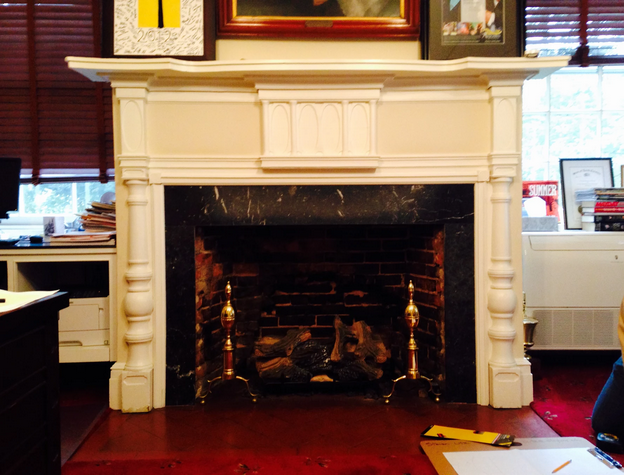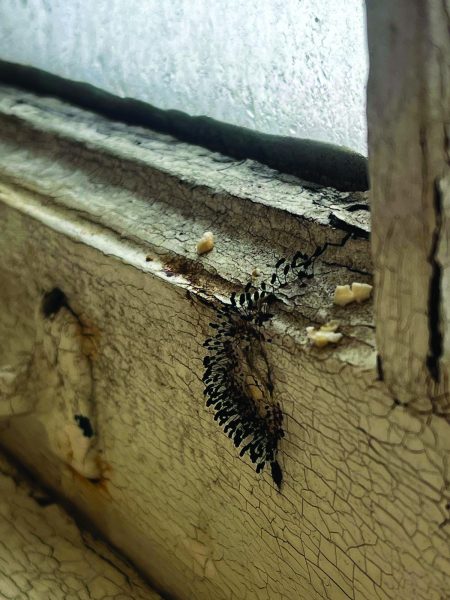Project documents historic buildings
Contributed by Christopher Brindle
The fireplace in President Mullen’s office is the last remaining original fireplace in Bentley Hall. Christopher Brindle, ’18, documented this fireplace as part of the project.
Steven Utz, the internship coordinator for the environmental science department and architectural history enthusiast, is currently in the process of documenting all of Allegheny’s historic buildings.
Utz said Allegheny College is a special place because of the unique and beautiful architecture.
“My first walk around Allegheny College[,] I was shocked at [its] beauty in landscape and buildings. It has buildings constructed during at least six different historic architecture periods and displays many different western styles,” Utz said in an email interview. “For an architecture history enthusiast, this is like walking through Candy Land … [It’s] a visual pleasure everyday.”
Utz is working with student interns to put together accurate blueprints using standards and guidelines developed by the Historic American Buildings Survey. These documents will then be stored in the Library of Congress, where they will be open to view by the public.
The only drawings that HABS currently has were done by Charles Stoltz in the 1930s.
“This is a large, multi-year project that will allow students with no architecture training to learn how to measure and draw historic architecture of the buildings on Allegheny’s Campus,” Utz said.
According to government standards, every drawing must be accurate within one-eighth inch, about the width of a headphone jack.
Utz said that to document the buildings with this level of accuracy, the students will use a variety of tools.
“They will use graphite pencils and red ballpoint pens to draw on large sheets of grid paper, measuring tape, orbital laser levels, plumb bobs, vertical telescoping measuring poles and contour gauges,” Utz said.
The project began in the fall of 2014 with Ruter Hall. Utz started working on Bentley Hall on his own during the spring of 2014 but has since had help from students.
Christopher Brindle, ’18, has been working with Utz for two semesters.
“My job for the first semester was to document the last original fireplace in Bentley,” Brindle said.
The fireplace currently resides in President James Mullen’s office on the first floor of Bentley Hall.
For his second semester he was tasked with mapping out the third floor.
“I’ve been up in the cupola where the bells are currently ringing,” Brindle said.
As a history major, Brindle was always interested in the historical significance of the buildings on campus.
When he was up in the cupola Brindle said the names carved into the walls were ones he recognized as the names of streets on and around campus.
Christina Truwit, ’17, studio art major, is also planning on being involved with the project this semester.
She said she has been interested in architecture since she was a child.
“I’m really excited that they have a program for [architecture] now because there isn’t a ton to do architecture-wise here at the school,” Truwit said.
Truwit said she plans to use this experience as part of her Senior Comprehensive Project.
“I am hoping to maybe enter an architecture design contest,” Truwit said.
The drawings the students have produced have yet to be finalized.
Once these drawings are completed, the campus community will have a greater understanding of these buildings as well as get to see detailed views of some of the architectural work that is out of reach for the casual observer.
There are no renovations currently planned for the buildings once they are documented, but Utz said he hopes to draw up a plan for Bentley Hall.
“I’m interested in helping develop a design for the third floor of Bentley which is currently unoccupied,” Utz said.
The third floor of Bentley contained the school’s first library. The original collection of materials has been moved to the Meadville Public Library.
“Buildings are indicators of our civilization, that ‘we were here’ and indicators in our mastery of materials and art. Buildings are an ever present expression of who we are as a society as our values, preference in style and color, shape and light are embodied in a physical structure,” Utz said.




